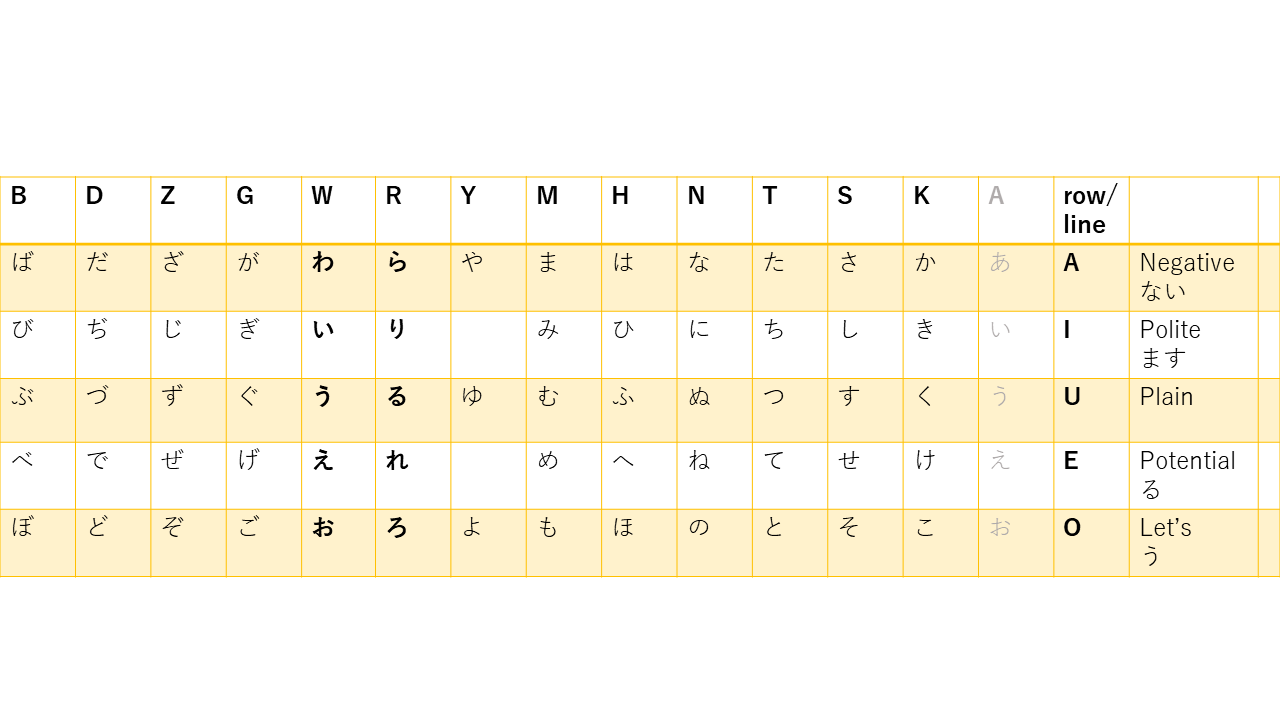I recommend not using the translate option to translate this webpage into English, so you can see the Japanese letters correctly.
When I teach Japanese, many students tend to get confused with verb conjugation. Some other websites explain verb conjugation, but in this blog, I want to make it as simple as possible, rather than giving too many examples.
The verb conjugation can be categorized as Group1, Group2, and Group3.
Group1 has the most confusing changes. Let’s start with Group1.
Group1
Verbs of a plain form which end in the following four patterns, can be categorized as Group1.
1-u e.g. Omou (think)
2-aRu e.g. Naru (become)
3-uRu e.g. Tsukuru (make)
4-oRu e.g. Noru (get on)
There are some exceptions of verbs that fall under Group1 instead of Group2.
Examples:
Hashiru (run) -iRu
Kaeru (return) -eRu
To explain Group1, I made a Hiragana chart which can be used for verb conjugation patterns.
All the letters in a line of U(う) show the last letter of verbs of a plain form. Change the letter in the line of U(う) to other letters following the Hiragana chart then add some letters.
It will be easier if I give you an example.
Let’s think about the word Omou (think).
In this case, U(う) is the last letter of the verb. So, you need to find U(う) in the Hiragana chart first.
In verb conjugation, please consider U(う) as the one in the row of W(わ) instead of the row of A(あ) in the Hiragana chart.
 Then apply conjugation of the verb “Omou”, following the rule in row W(わ) in the Hiragana chart.
Then apply conjugation of the verb “Omou”, following the rule in row W(わ) in the Hiragana chart.
Omowanai as a negative form (+nai)
Omoimasu as a polite form (+masu)
Omou as a plain form
Omoeru as a potential form (+ru)
Omoou as a let’s form (+u)
How to make te-form for Group 1 verb
Replace the last letter of a plain form following the rules below.
1 う、つ、る → って
e.g. おもう(think)→おもって
2 ぬ、ぶ、む → んで
e.g. あそぶ(play)→あそんで
3 く→ いて
e.g. きく(listen)→きいて
*Exception いく(go)→いって
4 ぐ→ いで
e.g. およぐ(swim)→およいで
5 す→ して
e.g. はなす(talk)→はなして
There is an exception in group 1.
A negative form of ある(be,exist) is ない
Group2
Group 2 is rather simple compared to group 1.
Verbs of a plain form which end in the following two patterns, can be categorized as Group2.
1 i-Ru e.g. Miru (see)
2 e-Ru e.g. Taberu (eat)
Let’s think about the word Taberu(eat) as an example.
If you want to conjugate the verb Taberu,
Simply delete Ru and then add some letters after Tabe(verb stem) to make different forms. For example, if you want to make a negative present form, just delete Ru and then add Nai. Following is the conjugation of the verb Taberu.
Tabenai as a negative form (+nai)
Tabemasu as a polite form (+masu)
Taberu as a plain form
Tberareru as a potential form (+rareru)
Tabeyo-u as a let’s form (+yo-u)
Tabete as a te-form (+te)
There are some exceptions of verbs that fall under Group1 instead of Group2.
Examples:
Hashiru (run) -iRu
Kaeru (return) -eRu
Group3
Group 3 are verbs that conjugate irregularly, but there are only two verbs. Simply memorize all the verb conjugation of group 3.
Suru(do)
Shi-nai as a negative form
Shi-masu as a polite form
Su-ru as a plain form
Deki-ru as a potential form
Shi-yo-u as a let’s form
Shi-te as a te-form
Kuru(come)
Ko-nai as a negative form
Ki-masu as a polite form
Ku-ru as a plain form
Ko-rareru as a potential form
Ko-yo-u as a let’s form
Ki-te as a te-form
As long as you have some knowledge of verb conjugations for the present tense, it is not so difficult to make the past tense. For example, you can make a plain past form using a similar way to make a te-form verb. Simply learn the facts on this page, then you can develop the basis of Japanese verb conjugation.
If you are interested in learning Japanese from me, please check the link below.





